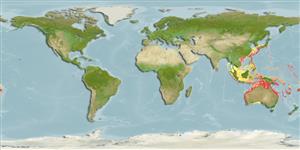>
Mulliformes (Goatfishes) >
Mullidae (Goatfishes)
Etymology: Upeneus: Greek, ypene, -es = upper lip (Ref. 45335); australiae: Named for its type locality, Australia.
Environment: milieu / climate zone / depth range / distribution range
Ecologia
marinhas demersal; intervalo de profundidade 3 - 82 m (Ref. 86942), usually 20 - 30 m (Ref. 98481). Tropical
Eastern Indian Ocean and Western Pacific: Australia and off New Caledonia.
Tamanho / Peso / Idade
Maturity: Lm ? range ? - ? cm
Max length : 16.0 cm SL macho/indeterminado; (Ref. 98481)
Espinhos dorsais (total) : 7; Raios dorsais (total) : 9; Espinhos anais: 1; Raios anais : 7; Vértebras: 24. This species is distinguished by the following characters: D VII + 9; pectoral fins 13-15; gill rakers 5-7 + 16-19 = 22-25. Adult measurements in %SL: body depth at first dorsal-fin origin 23-27 and at anus 20-23; caudal-peduncle depth 9.9-12; maximum head depth 20-22, while head depth through eye 15-18; head length 27-30; orbit length 6.0-8.0; upper jaw length 9.3-12; barbel length 16-20; caudal-fin length 27-32; anal-fin height 15-18; pelvic-fin length 20-23; pectoral-fin length 19-22; first dorsal-fin height 18-23 and second dorsal-fin height 14-18. Colouration: caudal fin with 7-13 bars in total, the upper caudal-fin lobe with 5-6 brown or black bars close to fin base, its width similar or narrower than the pale interspaces between bars; and the lower lobe with 6-8 bars of similar width as those on upper lobe, pale interspaces narrower and the 2-3 distal-most bars (one on tip) darker and wider; these caudal-fin lobe bars are mostly well-retained in preserved fish, especially on dorsal side of lower lobe; barbels are white; body and head white-silvery or pale beige, dark beige above lateral line, with a yellow-orange lateral body stripe from behind eye to caudal fin base in fresh fish; when preserved the body is pale brown and darkened dorsally (Ref. 98481).
Subadults and adults of this species occur at relatively shallow depths of the upper shelf and usually around 20-30 m (Ref. 98481). Adults feed mainly on shrimp (47%).
Ciclo de vida ou comportamento de acasalamento
Maturidade | Reprodução | Desova | Ovos | Fecundidade | Larvas
Kim, B.-J. and K. Nakaya, 2002. Upeneus australiae, a new goatfish (Mullidae:Perciformes) from Australia. Ichthyol. Res. 49(2):128-132. (Ref. 43139)
Status na Lista Vermelha da UICN (Ref. 130435: Version 2024-2)
Ameaça para os humanos
Harmless
Uso pelos humanos
Pescarias: espécies comerciais
Ferramentas
Relatórios especiais
Baixar XML
Fontes da internet
Estimates based on models
Preferred temperature (Ref.
123201): 20.9 - 28.5, mean 27 °C (based on 504 cells).
Índice de diversidade filogenética (Ref.
82804): PD
50 = 0.5000 [Uniqueness, from 0.5 = low to 2.0 = high].
Bayesian length-weight: a=0.01023 (0.00595 - 0.01759), b=3.10 (2.95 - 3.25), in cm total length, based on LWR estimates for this species & Genus-body shape (Ref.
93245).
Nível Trófico (Ref.
69278): 3.4 ±0.0 se; based on diet studies.
Resiliência (Ref.
120179): Elevada, tempo mínimo de duplicação da população menor que 15 meses (Preliminary K or Fecundity.).
Fishing Vulnerability (Ref.
59153): Low vulnerability (10 of 100).
